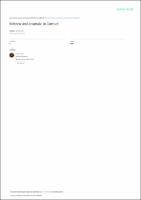Please use this identifier to cite or link to this item:
https://hdl.handle.net/20.500.12202/9884Full metadata record
| DC Field | Value | Language |
|---|---|---|
| dc.contributor.author | Koller, Aaron | - |
| dc.date.accessioned | 2024-02-28T22:49:51Z | - |
| dc.date.available | 2024-02-28T22:49:51Z | - |
| dc.identifier.citation | Koller, A. (2020). Hebrew and Aramaic in contact. In: R. Hasselbach-Andee (Ed.), A companion to Ancient Near Eastern languages, (pp. 439-455). Blackwell. | en_US |
| dc.identifier.isbn | 9781119193890 | - |
| dc.identifier.uri | https://www.researchgate.net/publication/339921976_Hebrew_and_Aramaic_in_Contact | en_US |
| dc.identifier.uri | https://hdl.handle.net/20.500.12202/9884 | - |
| dc.description | Book chapter | en_US |
| dc.description.abstract | Canaanite and Aramaic diverged at some point prior to the middle of the second millennium bce. Distinctively Canaanite features are evident in Amarna Canaanite and in Late Egyptian transcriptions of Canaanite words (Hoch 1994); the split may have been as early as the mid‐third millennium bce (Steiner 2011). Although both Canaanite and Aramaic developed distinctive features (see Pat‐El and Wilson‐Wright 2016, and Huehnergard 1995, respectively), of course only one branch had to develop innovative features to effect the split; Canaanite seems to have broken off first from the proto‐language, and the distinctive features of Aramaic then developed over the course of the second millennium. __Despite this ancient rift, languages of the two families lived in close proximity for millennia. This chapter will set aside most of the Canaanite languages, such as Phoenician, and concentrate on Hebrew and its relationship with Aramaic. Over the course of the first millennium bce and into the first millennium ce, mutual influences can be seen in the texts composed in Hebrew and Aramaic. __Because the two languages are both fairly closely related and were in contact for many centuries, it is often difficult to discern what is a shared inheritance and what is a borrowing in one language from the other (see Pat‐El 2013, 317 for this methodological problem). (from Introduction) | en_US |
| dc.language.iso | en_US | en_US |
| dc.publisher | Blackwell | en_US |
| dc.relation.ispartofseries | Bernard Revel Graduate School: Faculty Publications; | - |
| dc.rights | Attribution-NonCommercial-NoDerivs 3.0 United States | * |
| dc.rights.uri | http://creativecommons.org/licenses/by-nc-nd/3.0/us/ | * |
| dc.subject | Hebrew language. | en_US |
| dc.subject | Semitic languages | en_US |
| dc.subject | Rabbinical literature --History and criticism. | en_US |
| dc.subject | Festschriften. | en_US |
| dc.subject | Bible --Criticism, interpretation, etc. | en_US |
| dc.subject | Festschriften. Steiner, Richard. C. | en_US |
| dc.title | Hebrew and Aramaic | en_US |
| dc.type | Book chapter | en_US |
| dc.contributor.orcid | 0009-0001-4065-6747 | en_US |
| local.yu.facultypage | https://www.yu.edu/faculty/pages/koller-aaron | en_US |
| Appears in Collections: | Bernard Revel Graduate School of Jewish Studies (BRGS): Faculty Publications | |
Files in This Item:
| File | Description | Size | Format | |
|---|---|---|---|---|
| Koller OA HebrewandAramaicinContact2020.pdf | 457.8 kB | Adobe PDF |  View/Open |
This item is licensed under a Creative Commons License

